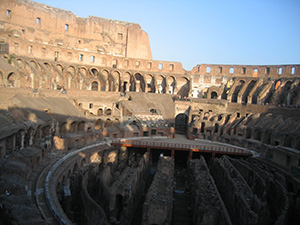Visiting the Colosseum in Rome, Italy
During a recent trip to Rome, where I did a lot of sight-seeing, what most impressed me was the majestic Colosseum. The Colosseum is an amphitheater dedicated to gladiatorial combats. Originally, the amphitheater was called “Flavian Amphitheater” from the imperial dynasty of that name. However, since the Middle Ages it has been known as “Colosseum” due to a huge bronze statue of the emperor Nero, the “Colossus of Nero” which used to stand beside it.
It has a capacity of 50,000 spectators and it is considered to be the ideal model for amphitheater architecture. What we see today is a ruin of the Colosseum as two thirds of the original has been destroyed due to fires and earthquakes.
History of the Amphitheater
The building of the Colosseum started in 72 A.D. under the rule of the emperor Vespasian who had decided to erect the amphitheater from his general's share of booty for the celebration of the victory of the Romans in the Great Jewish Revolt in 70 A.D. The three stories had been constructed during Vespasian's rule. After he died, his son Titus, finished the top level and organized the inauguration. During the inaugural games an ancient source reports that over 9,000 wild animals were killed.
The amphitheater was completed with a hypogeum, a series of underground tunnels that housed animals and slaves.
The Colosseum used to serve until the 5 century A.D. when the bloody games were abolished as they weren't favored any more by the largely Christian public. It also had been used as the place of numerous martyrdoms of early Christians.
Architecture
The Colosseum is considered to be the grandest and most functional amphitheater ever build. Its enormous size is a diameter of 188 meters, with a height of 50 meters.
The facade was made of big blocks of travertine which were brought from Tivoli and it has four levels. What makes the Colosseum look so nice is the harmony derived from the ordered beauty and formal regularity. Its exterior part consists of three stories of arches with engaged columns. The columns are of different rhythm; Tuscan at the bottom, then Ionic, with Corinthian on the third story.
The Shows
The Colosseum was mostly used to host gladiatorial combats in order to demonstrate power and family prestige and were very popular with the population. The protagonists of these combats were usually prisoners of war or slaves, but also free men fought for wealth and fame. The only way these individuals wouldn't die in the combat was if the emperor or public showed mercy and in that case the loser would have left free.
Another type of show, put on to celebrate victory, was the animal hunt with wild beasts (lions, panthers, leopards, bears, rhinoceroses, giraffes and gazelles) imported from territories that the Roman emperors had conquered. The stage was set up to reproduce the animal's natural habitats. The hunters, who were usually condemned criminals, were allowed to defend themselves only with a lance and a shield and of course they would end up in pieces.
During the intervals of these games other shows took place like jugglers, acrobats and magicians. Dramas were also performed based on ancient mythology and they would often finish with a gruesome death of the actors.
Today the Colosseum is one of the most popular tourist attractions in Rome. It is a monument to Roman imperial power and cruelty.




Leave a Reply